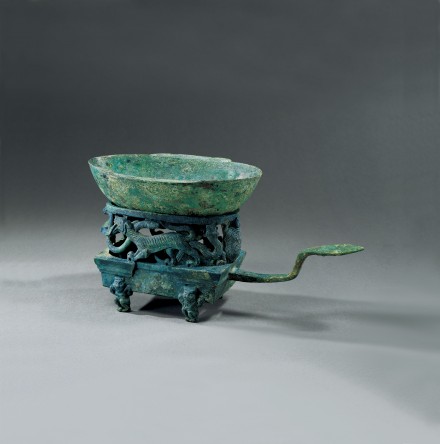J.J. Lally & Co., Oriental Art / New York City, New York
MenuPast Exhibition
Arts of Ancient China
March 27 - April 12, 2006

16.
A BRONZE BRAZIER AND A BRONZE WINE CUP
Late Western Han – Early Eastern Han, 1st Century B.C.- A.D. 1st Century
the rectangular fire box with a stepped cornice on the exterior, supported on the backs of four small caryatid-like supports in the form of muscular foreigners with broad noses and bulging eyes, the wide oval upper section well-cast in openwork relief with the animal-spirits of the four cardinal directions (si shen): the Azure Dragon of the East (qinglong) and the White Tiger of the West (bai hu) on the longer sides, the latter interlaced with an eel-like fish and a serpent and shown biting the tail of the Vermilion Bird of the South (zhuque) at the rounded front end, the Tortoise entwined with a snake symbolizing the Dark Warrior of the North (xuanwu) at the opposite end above the projecting handle with stepped-up spade-shaped terminal, the flat base cast with open slots, the surface encrusted with blue-green patination and traces of buff-colored earth from burial; together with a large bronze earcup (erbei) of wide oval form with two ear-handles at the rim decorated in linear relief with panels of dotted and striped lozenge pattern and with a winged dragon cast in the same raised-line style within a matching border filling the recessed oval center of the cup which projects slightly on the underside to form a flat base, the surface with lightly encrusted dark green patination.
Length of brazier 10 1/2 inches (26.7 cm)
Length of cup 7 1/8 inches (18.1 cm)
A very similar bronze brazier from the collection of the Brooklyn Museum was exhibited at the Princeton University Art Museum and is illustrated in the catalogue entitled Recarving China’s Past: Art, Archaeology, and Architecture of the “Wu Family Shrines,” New Haven and London, 2005, p. 355, no. 30, with a detailed description by Hiromi Kinoshita wherein the author cites two braziers of this type both found together with eared cups in Han Dynasty tombs in Shanxi province, the first published in Wenwu, 1987, No. 6, pl. 3, no. 3, and again in color in Zhongguo Qingtongqi Quanji, (Compendium of Chinese Bronzes), Vol. 12, Qin and Han Dynasties, Beijing 1998, p. 79, no. 77, the second, excavated at Taiyuan, is illustrated in Kaogu, 1985, No. 6, pl. 6, no. 1
Other Han bronze braziers of this same form and design are in several museum collections including the Shanghai Museum, illustrated in Shanghai Bowuguan Cang Qintong Qi, p. 1.98, in the British Museum, illustrated by Watson in The British Museum Handbook to the Collections of Early Chinese Antiquities, London, 1962, p. 53, fig. 14c, in the Chicago Art Institute, illustrated by Kelley and Ch’en in Chinese Bronzes from the Buckingham Collection, Chicago, 1946, p. 112, pl. LXV-LXVII, together with earcups, in the Fujii Yurinkan Museum, Kyoto, illustrated by Umehara in Nihon Shucho Shina Kodo Seikwa (Selected Relics of Ancient Chinese Bronzes from Collections in Japan), Vol. VI, pl. CCCX, and in the Musée Cernuschi, Paris, illustrated by Deydier in Chinese Bronzes, Fribourg, Switzerland, 1980, p. 125, pl. 92.
A very similar ‘ear cup’ cast with closely related decoration in the same linear-relief style is in the E’xi Autonomous Region Museum in Hubei province is illustrated in Wenwu, 1990, No. 3, pl. 7, no. 6, and in line drawing on p. 48, fig. 10.
西漢-東漢早期 四神溫酒銅爐及銅盃
爐長 26.7 厘米 杯長 18.1 厘米
16.
A BRONZE BRAZIER AND A BRONZE WINE CUP
Late Western Han – Early Eastern Han, 1st Century B.C.- A.D. 1st Century